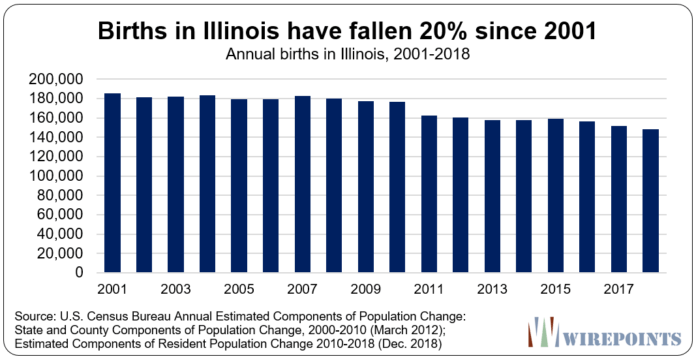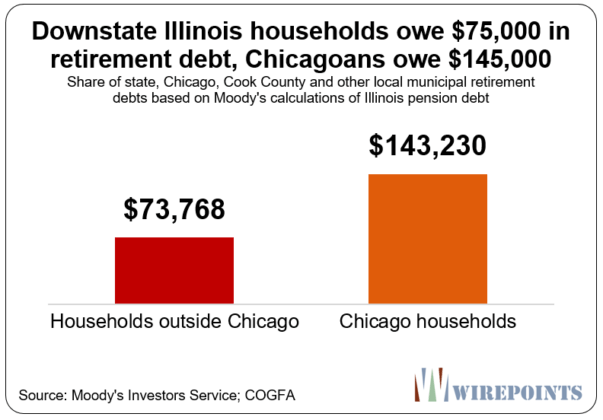Authored by Ted Dabrowski and John Klingner via WirePoints.org,
A Centers for Disease Control report on the drop in births nationally has experts worried about its impact on the country’s fiscal and economic situation. Fewer young people could mean a shrinking population and a workforce too small to support the country’s ever-growing number of retirees.
If that’s a problem nationally, then it’s a full-on crisis in Illinois. According to separate U.S. Census data analyzed recently by Wirepoints, Illinois’ birth rate has fallen faster than the national average since the turn of the century. And that’s a real issue given the state’s massive pension debts and its declining population.
Barring structural pension reforms, Illinois will be trapped in a downward spiral where growing government debts fall on fewer and fewer people.
Births down
According to the CDC, the number of U.S. births nationally declined to a 32-year low in 2018. The reasons for that were varied; teens and hispanic women are having less children while the increase for older women (ages 40-44) has slowed, among other factors. Births in the U.S. have fallen in 10 of the last 11 years.
State-level data from the U.S. Census Bureau confirms that negative birth trend and shows just how worse off Illinois is compared to other states.
It also captures an additional factor on state births the national average doesn’t: the potential effects of domestic migration. As more millennials move out of Illinois, there’s likely to be a negative impact on births. Illinois lost a net of 107,000 millennials and their dependents to other states between 2012 and 2016, according to data from the Internal Revenue Service. And a Brookings Institution report found Illinois and West Virginia were the only two states in the nation to lose millennials between 2010 and 2015.
Compared to 2001, Illinois births have dropped 20 percent. Wirepoints covered that drop in a recent study: Illinois’ demographic collapse: fewer immigrants, fewer babies and fleeing residents.
Illinois’ drop in births has been more dramatic than in most states in the nation. In 2001, the state’s births per 1,000 residents put Illinois 12th-best in the nation. But by 2018, the state’s ranking had fallen to 30th.
In contrast, most of Illinois neighboring states improved their birth rankings over the 2001-2018 period.
Illinois’ drop in births, combined with a 50 percent drop in international immigration and record domestic outmigration, has resulted in a shrinking Illinois population five years in a row.
Bigger debts, too few people
Which brings us back to the concerns of too few young people to pay for the state’s burgeoning debts.
Illinois has racked up more than $420 billion in public sector retirement debts at the state and local levels, based on Moody’s more conservative assumptions for pensions.
Divvy those debts up based on households inside and outside of Chicago, and the numbers are impossible.
Households outside of Chicago are each on the hook for $75,000 for their share of state, Cook County and municipal retirement debts.
Chicagoans have it even worse. Each Windy City household is on the hook for nearly $145,000 for their share of Chicago, Chicago Public Schools, Cook County and state debts.
Those are truly startling numbers, and they’re only going to get worse as more Illinoisans leave.
And if lawmakers want to make the repayment of those debts “progressive,” the numbers get even scarier.
Read more about Illinois downward spiral:
- Illinois’ demographic collapse: fewer immigrants, fewer babies and fleeing residents
- Moody’s vs. Illinois politicians: $100 billion difference in pension debts
- Illinois’ crisis: 20 facts Pritzker doesn’t want ordinary Illinoisans to know
- Pritzker’s progressive tax push: A guide for the ordinary Illinoisan
via ZeroHedge News http://bit.ly/2JtOsEt Tyler Durden


